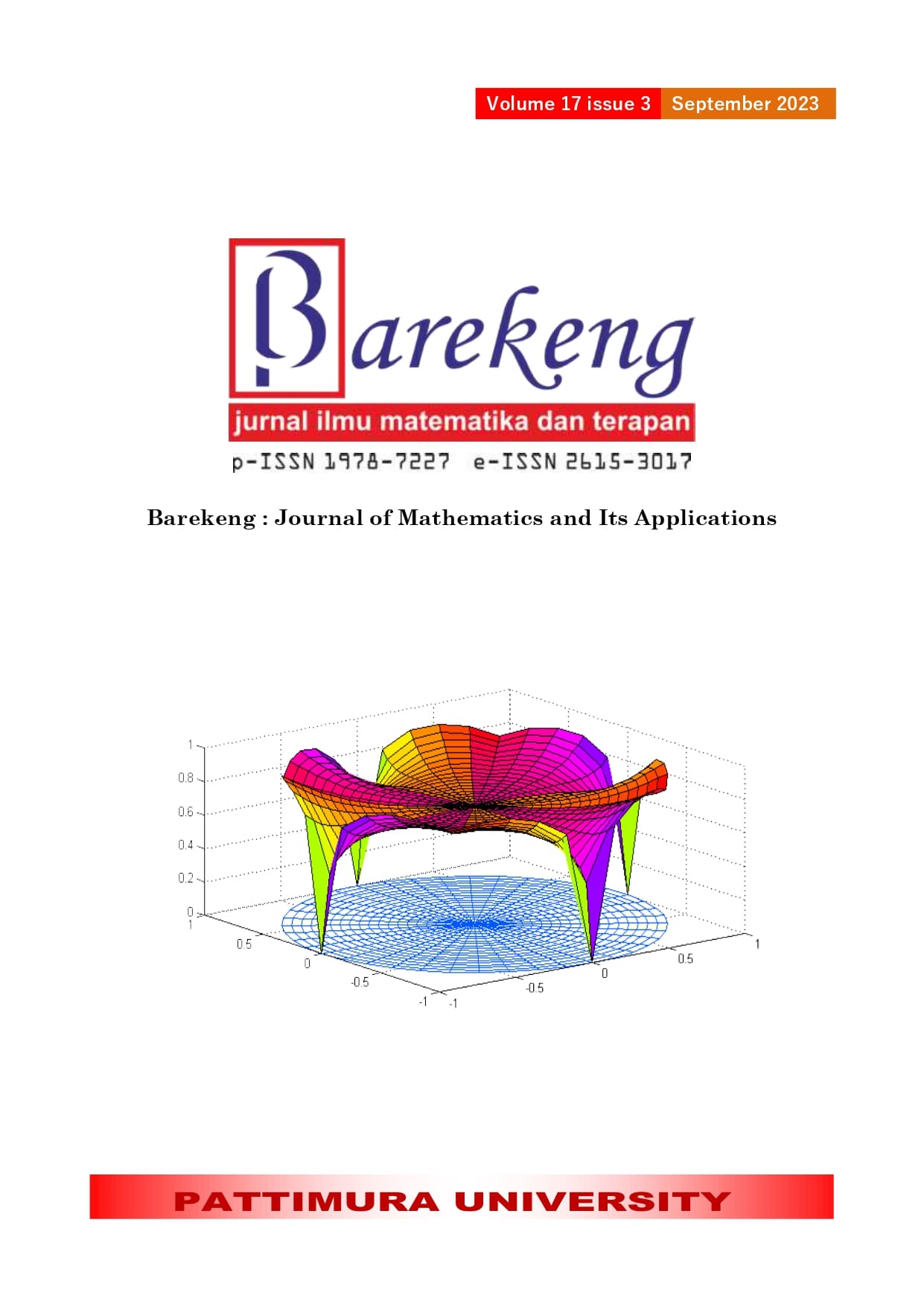ANALYSIS OF COMMUNITY COMPLIANCE WITH THE COVID-19 HEALTH PROTOCOLS: A QUANTITATIVE ANALYTICAL APPROACH
Abstract
This study identifies the factors used in factor analysis that influence the compliance of the people of Bali Province to the COVID-19 health protocol. Based on the factor analysis results, the elimination of four variables from the initial 20 variables in the study because the low communality value was below 0.5. Thus, reducing the remaining 16 variables to six factors with a total variance of 74.8%. Six factors influenced Community compliance in Bali Province, namely someone who knows about the importance of health protocols (19,1%), trust in protocols (15,9%), someone infected with COVID-19 (12,2%), a sense of concern for themselves and their families (10,1%), government supervision and sanctions (9,3%), and the affordable price of masks (8,2%). Observing this study, the first factor that played a role in increasing adherence was knowledge about the importance of health care. There was a sense of trust in health protocols, and a less influential factor was the affordability of masks
Downloads
References
SatGas COVID-19, ‘Peta Sebaran’, 2022. https://covid19.go.id/peta-sebaran (accessed Sep. 02, 2022).
Kominfo, ‘Pemerintah Tetapkan Tiga Kerangka Strategi Hadapi Lonjakan Kasus Covid-19’, 2021. https://www.kominfo.go.id/content/detail/35405/pemerintah-tetapkan-tiga-kerangka-strategi-hadapi-lonjakan-kasus-covid-19/0/berita (accessed Sep. 17, 2021).
Sekretariat Presiden, ‘Pemerintah Longgarkan Kebijakan Pemakaian Masker bagi Masyarakat’, 2022. https://covid19.go.id/artikel/2022/05/17/pemerintah-longgarkan-kebijakan-pemakaian-masker-bagi-masyarakat (accessed Sep. 02, 2022).
W. L. Neuman, Social Research Methods: Qualitative and Quantitative Approaches, Seventh Ed. USA: Pearsons Education Limited, 2014.
S. Grønmo, Social Research Methods: Qualitative, Quantitative and Mixed Methods Approaches. UK: SAGE Publications Ltd, 2019.
N. Irwani, ‘Persepsi Masyarakat terhadap Penerapan Protokol Kesehatan pada Masa Pandemi COVID-19 di Kecamatan Batang Kuis Kabupaten Deli Serdang’, Universitas Muhammadiyah Sumatera Utara Medan, 2021.
S. R. Abrily, A. N. Hamdie, and Sugiannor, ‘Implementasi Kebijakan Penerapan Protokol Kesehatan di Desa Sungai Sipai Kecamatan Martapura Kab. Banjar’, Universitas Islam Kalimantan Muhammad Arsyad Al-Banjar Banjarmasin, 2021.
R. S. Garusu, F. Warouw, R. H, and Akili, ‘Gambaran Perilaku Masyarakat dalam Penerapan Protokol Kesehatan untuk Pencegahan Covid-19 di Desa Wulurmaatus Kecamatan Modoinding’, J. KESMAS, vol. 10, no. 4, pp. 24–29, 2021.
J. W. Creswell and J. D. Creswell, Research Design: Qualitative, Quantitative, and Mixed Methods Approaches, Fifth edit. Thousand Oaks, California: SAGE Publications, 2018.
J. F. Hair, R. E. Anderson, R. L. Tatham, and W. C. Black, Multivariate Data Analysis, Eigth Edit. United Kingdom: Cengage Learning EMEA, 2019.
J. W. Creswell, Research Design: Qualitative, Quantitative, and Mixed Methods Approaches, 3rd ed. SAGE Publications. Inc., 2009.
R. Johnson and D. Wichern, Pearson New International Edition-Applied Multivariate Statistical Analysis, Sixth Edit. United States of America: Pearson, 2014.
G. Glasgow, Stratified Sampling Types. New York: Elsevier, 2005.
F. Shi, ‘Study on a Stratified Sampling Investigation Method for’, Discret. Dyn. Nat. Soc., vol. 2015, pp. 1–7, 2015.
W. Revelle, ‘psych: Procedures for Psychological, Psychometric, and Personality Research’, Art. no. R package version 2.3.6, 2023, [Online]. Available: https://cran.r-project.org/package=psych .
R. Smyth and A. Johnson, ‘Factor Analysis’, pp. 1–15.
B. G. . Tabachnick and L. S. Fidell, Using Multivariate Statistics. Pearsons Education Limited, 2014.
R. Taylor, ‘Interpretation of the Correlation Coefficient : A Basic Review’, pp. 35–39, 1990, doi: https://doi.org/10.1177/875647939000600106.
S. Notoatmodjo, Pendidikan dan perilaku kesehatan. Jakarta: Rineka Cipta, 2003.
A. Elia, D. Jaya, S. Neneng, T. Anden, M. Haryulin, and H. Segah, ‘Heliyon State versus action orientation and compliance during the COVID-19 pandemic in Indonesia’, Heliyon, vol. 8, no. September, p. e10725, 2022, doi: 10.1016/j.heliyon.2022.e10725.
F. N. S. Damanik, ‘Menjadi Masyarat Informasi’, vol. 13, no. 1, pp. 73–82, 2012.
Humas Litbangkes, ‘Peningkatan Kepercayaan Masyarakat sebagai Modal Sosial Cegah Covid-19’, 2020. https://www.litbang.kemkes.go.id/peningkatan-kepercayaan-masyarakat-sebagai-modal-sosial-cegah-covid-19/ (accessed Sep. 28, 2022).
P. M. Kearney et al., ‘Cross-sectional survey of compliance behaviour , knowledge and attitudes among cases and close contacts during COVID-19 pandemic’, Public Heal. Pract., vol. 5, no. November 2022, p. 100370, 2023, doi: 10.1016/j.puhip.2023.100370.
S. K. Rph, H. Suh, C. Nam, and H. K. Rph, ‘Motivating factors of compliance to government ’ s COVID-19 preventive guidelines : An investigation using discrete choice model’, AJIC Am. J. Infect. Control, vol. 000, 2023, doi: 10.1016/j.ajic.2022.12.013.
Copyright (c) 2023 I Komang Gde Sukarsa, GK Gandhiadi

This work is licensed under a Creative Commons Attribution-ShareAlike 4.0 International License.
Authors who publish with this Journal agree to the following terms:
- Author retain copyright and grant the journal right of first publication with the work simultaneously licensed under a creative commons attribution license that allow others to share the work within an acknowledgement of the work’s authorship and initial publication of this journal.
- Authors are able to enter into separate, additional contractual arrangement for the non-exclusive distribution of the journal’s published version of the work (e.g. acknowledgement of its initial publication in this journal).
- Authors are permitted and encouraged to post their work online (e.g. in institutional repositories or on their websites) prior to and during the submission process, as it can lead to productive exchanges, as well as earlier and greater citation of published works.






1.gif)



